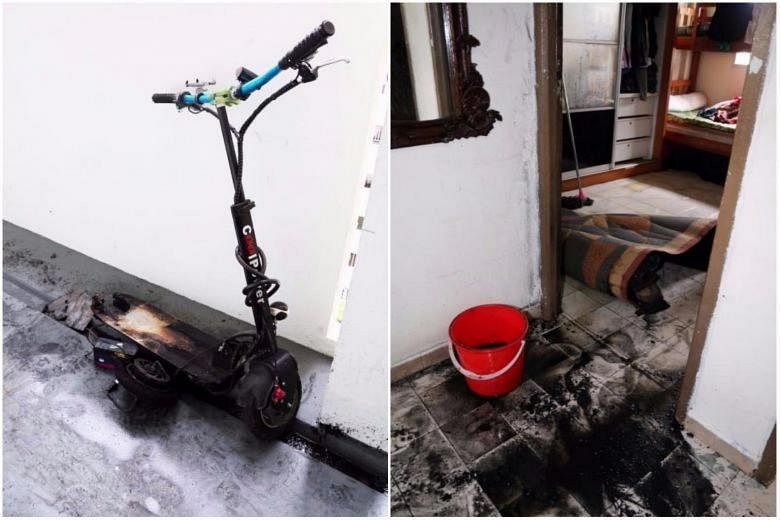The number of electric scooters that burst into flames last year soared even as the number of fire calls in Singapore fell to a 40-year low.
The Singapore Civil Defence Force (SCDF) said yesterday that 40 e-scooters caught fire, a sharp rise from nine in 2016.
Batteries, with flammable material, are often the cause because excessive impact, overcharging and faulty electrical circuitry can "trigger a fire", said its spokesman.
The damage to property and potential loss of lives have led some, like the family of shipping engineer Kamil Ithnin, 31, to ban family members from owning the machines.
Mr Kamil's 23-year-old brother Ridwan suffered burns on 45 per cent of his body last November when his e-scooter flared up as it was being charged in his bedroom in their Yishun flat.
His father and sister-in-law were also hospitalised after trying to put out the fire.
Yesterday, he told The Straits Times the damage came to about $900, but the trauma was worse. "I've warned my family never to buy one again," he added.

-
3,871
Number of fires last year, down from 4,114 calls in 2016.
The figures SCDF released yesterday show there were 3,871 fires across Singapore last year, a drop from 4,114 in 2016.
About half were caused by the indiscriminate disposal of lighted materials, such as cigarette butts, charcoal embers and incense sticks.
Seven in 10 fires happened in homes while one in 10 took place in non-residential buildings, such as shopping centres, markets and factories.
The rest were in vehicles and among vegetation and rubbish that piled up in open spaces.
Three people died and 60 were injured in the fires, compared with two deaths and 62 injuries in 2016.
The SCDF held 14,802 fire safety enforcement checks last year, during which officers issued 2,543 notices on fire hazards. These range from exit signs not being illuminated to obstruction of exits and fire engine access ways.
The officers also issued 2,845 notices of fire safety offences, including illegally turning spaces into workers' dormitories and storing flammable materials without licence.
The SCDF spokesman said firm action will be taken against those who fail to take corrective measures despite warnings and fines.
Emergency medical service calls at 20-year high
The Singapore Civil Defence Force (SCDF) received a record number - a 20-year high - of calls requiring emergency medical services, of which every one in 10 was for a life-threatening case.
These potentially fatal emergencies are in the apex category of a new four-tiered response framework that the SCDF put in place last year.
They made up 20,733 calls for cases including cardiac arrest, breathlessness and stroke.
According to annual SCDF statistics released yesterday, the force received 182,502 emergency medical service (EMS) calls - or about 500 a day - last year, with 88.9 per cent of them attended to within 11 minutes.
Of the EMS calls, 163,563 calls were about emergencies. The rest were non-emergency calls or false alarms.
Medical-related calls formed 75.5 per cent of the emergency calls. Trauma cases, such as industrial accidents, falls and assaults, made up 18.2 per cent, with the rest being traffic accidents.
Last year, the SCDF received 4,348 more EMS calls than in 2016, continuing a rising trend since 1998.
The number of calls is expected to increase as Singapore's population continues to grow, the SCDF spokesman said.
He added that the greying population will also require more emergency services.
Four in 10 calls last year were for those aged 65 and above, the highest among all age categories.
The rise in the number of calls "affirms the need for SCDF's tiered response framework, so that scarce resources can be prioritised for the more urgent, severe cases", he added.
In April last year, the force shifted to an EMS tiered-response framework, amid tightened manpower resources and a rising number of 995 calls.
The new framework prioritises 995 calls based on callers' answers to a series of questions to determine the seriousness of patients' medical conditions. The tiers are non-emergencies, minor emergencies, emergencies and life-threatening emergencies.


